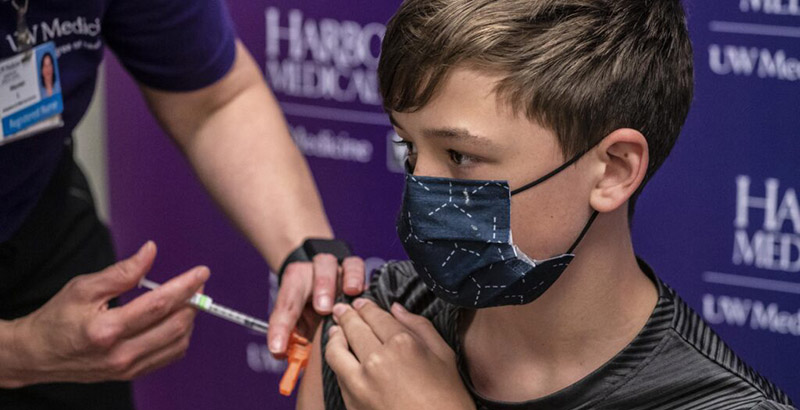Case Study: With Only 18% of Young Children in Nebraska Vaccinated, Experts Warn Schools Are Providing ‘Kindling’ for Wider COVID Outbreaks

Get stories like this delivered straight to your inbox. Sign up for The 74 Newsletter
Schools provide the “kindling” for viral outbreaks, and schoolchildren are getting infected at higher rates right now, making it essential that more kids get vaccinated for COVID-19, two Nebraska health experts said Sunday.
Only 18.5% of children 5-11 years old in Nebraska have been vaccinated so far, and 51.1% of youths 12-19 have gotten shots, or about 114,500 total.
Those numbers “haven’t shown much growth in the past few weeks,” said Dr. Gwenn Skar, a pediatric infectious disease authority at Children’s Hospital in Omaha.
“I love that we have this many kids vaccinated,” she said. “But we really have a lot of work to do.”
At the beginning of the pandemic, Skar added, only 2.6% of all cases involved children, but that figure has risen to 25.5% of all cases now.
She was joined by Dr. James Lawler, director of the Global Center for Health Security at the University of Nebraska Medical Center for a Zoom call update Sunday night for school officials on COVID-19.
Hospitalizations are spiking
The call was set up by the state teachers union, the Nebraska State Education Association, and was cosponsored by the Nebraska Council of School Administrators.
They spoke as hospitalizations for coronavirus have spiked. As of Thursday, 754 Nebraskans were in hospitals for COVID-19, according to the State Department of Health and Human Services, the highest number since November 2020, when 978 were hospitalized Nov. 17.
Lawler said Sunday that schools act as the “kindling” for community outbreaks of COVID and flu because students get more and longer exposure to respiratory infections in crowded school buses and classrooms.
Lawler said a major “myth” about kids and COVID is that few get infected.
“That’s only true because we’re not looking,” he said.
Children, Lawler said, are tested at a much lower rate than adults in the United States, so the true infection numbers don’t show up.
Infections rising faster among children
Blood tests that are given for other reasons than COVID show that infections among children are rising faster than with other age groups, he said.
As of August 2020, 10% of children 17 or younger showed evidence they had been infected, based on the blood tests. By November 2021, that figure had risen to 45%, Lawler said. That compares with 35% of adults ages 18-49 showing evidence of infection and less than 20% of those 65 and over.
“The only explanation for this is that children ages zero to 17 are getting infected at a higher rate than anyone else now,” Lawler said.
He doesn’t agree with some observers who are saying the current wave of infections caused by the Omicron variant might portend the end of the pandemic.
He said he doesn’t see evidence the virus has “exhausted all of its opportunities to create new variants.”
Reduces hospitalization
Communities that aren’t well-vaccinated provide the opportunity for the virus to mutate and launch a new wave of infections, he said. That means it’s a “safer bet” that new variants will arise, according to Lawler, until the population is fully vaccinated at rates of 80% or higher.
Other takeaways from the Zoom presentation include:
- Multisystem Inflammatory Syndrome in Children (MIS-C) is a dangerous side effect that can show up two to six weeks after a child is infected. It shows up in about 1 of every 3,200 infections, Skar said. The syndrome can cause damage to internal organs, including the liver and kidney. Children’s Hospital has treated about 100 children for the syndrome since the pandemic started, she said.
- Heart problems such as pericarditis among children is “very, very rare,” involving approximately 54 cases per million, mainly involving 16- and 17-year-old males.
- A study in Georgia found that schools that didn’t have mask requirements were 3.5 times more likely to have COVID outbreaks.
- Vaccination works for children, Skar said. Children are 93% less likely to be hospitalized for COVID-19 if vaccinated, she said.
Nebraska Examiner is part of States Newsroom, a network of news bureaus supported by grants and a coalition of donors as a 501c(3) public charity. Nebraska Examiner maintains editorial independence. Contact Editor Cate Folsom for questions: info@nebraskaexaminer.com. Follow Nebraska Examiner on Facebook and Twitter.
Get stories like these delivered straight to your inbox. Sign up for The 74 Newsletter

;)